How buses show enthusiasts new perspectives about Singapore - and themselves
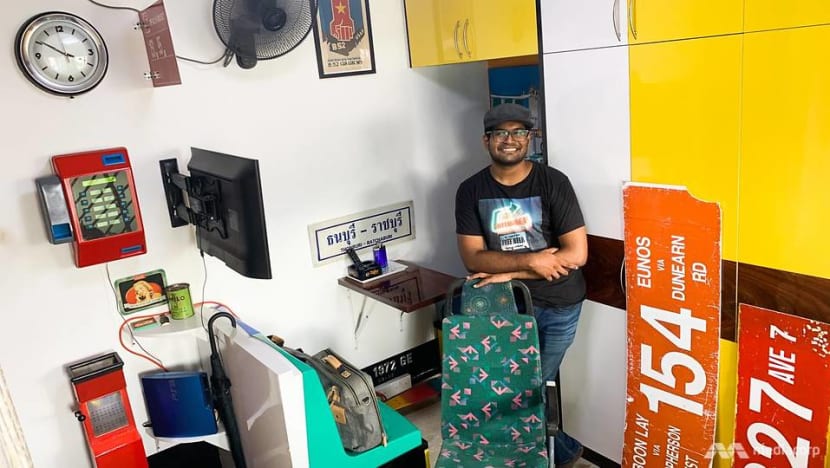
Bus enthusiast Santhosh Kumar has amassed various bits of memorabilia over the years. (Photo: Matthew Mohan)
SINGAPORE: Nestled in his favourite seat close to the back of the bus, 21-year-old bus enthusiast Santhosh Kumar is in his element.
When he takes buses with friends, he is "either a conversation killer, or everybody just quietens down (when I speak) … They say I’m an old man in a young man’s body - because I'm 21 years old, but I sound like I have 71 years of experience,” he told CNA.
“I’m just passionate about everything around me, so when I’m passionate about something, I share it with others.”
And share he does.
During a 15 minute ride on bus service 170, Mr Kumar brings to life a route which to the unknowing eye would have seemed nothing but nondescript.
As the bus whizzes along, he picks out the former Lee Kiat Seng workshop, where workers used to assemble buses for Singapore Traction Company. Just minutes down the road stands one of the oldest surviving petrol stations on the island, a quaint Shell station with a couple of gas pumps and a Route 66 vibe.
Mr Kumar has picked this ride for a reason. It is one of the longest-existing bus routes in Singapore, and started off as route number 1 for the long-defunct Green Bus Company more than 70 years ago, he explained. And just as it had in the past, the cross-border bus service ends at Queen Street Bus Terminal.
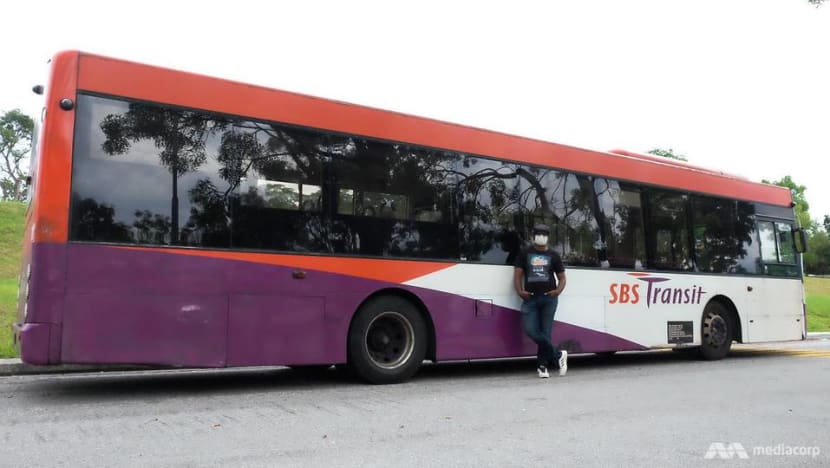
“This route is useful for me. Because I stay in Bukit Panjang, this bus passes by,” added the Ngee Ann Polytechnic student, who estimates that there are between 300 to 400 bus enthusiasts like him in Singapore. “It’s almost like at the back of my mind - whenever I want to go somewhere, suddenly 170 becomes the route of choice."
While his hobby is an unusual one, enthusiasts like Mr Kumar say a bus ride remains a fun way of exploring parts of Singapore people are unfamiliar with.
"The MRT goes underground, you don't see much, you just reach your destination. Even if its above ground, its going so fast - you don't really see much. Buses stop at every bus stop - you get to see even the hidden nooks and crannies. That's why I prefer buses," said Mr Kumar.
"If you actually go out, take the bus and go see every nook and cranny, just imagine how many stories and places you will hear and see, and the people you will meet."
Amid a pandemic where overseas travel remains out of reach for most, this represents the "perfect time" to jump on buses to explore, said fellow bus enthusiast Syabiel Ahmed.
"If you take a bus somewhere, you can find out more about certain places that you normally wouldn't see if you deviate from the (usual) route. Now is the perfect time because there's nowhere else to travel," said the 25-year-old.
A SCHOOLKID AT THE SCRAPYARD
Mr Kumar’s love affair with buses began when he was around four-years-old.
“In our living room, the sofa is adjacent to the window. And right below is the bus stop for service 307. It was the only bus service which operated in this estate. So every 15 minutes or 30 minutes, a bus would come back round, and it would echo throughout the estate,” he recalled.
“It's very striking - the orange, yellow, white colors … The bus comes to a stop right in front of my house … You hear people tapping their ez-link cards, the bus drives off and a few minutes later it comes back again. So it was a constant sight of this that made me really intrigued.”
When he was slightly older, Mr Santhosh would beg his parents to use the computer at home. Not to play games, but to look up information on buses.
“What I did was … search about buses, Singapore buses, where did this bus come from, what exactly is the name for this bus?” he explained. “My eldest brother would come to me and say: ‘Why do you like buses, why not cars?’ And then he would search for cars and show me cars.”
As his love for buses developed, a fellow enthusiast introduced Mr Kumar to the local scrap yards. It was at these places where the youngster would painstakingly hunt for hidden gems and convince the scrapyard owners to part with them, before lugging the bus parts home.
“I started going there when I was Primary 6 or Secondary 1. I spent most of my childhood in Sungei Kadut after school in my school uniform. You can ask my parents, my school shoes would go from white to brownish,” he recalled.
When he was 16, Mr Kumar even tried to buy a bus destined for the scrap heap.
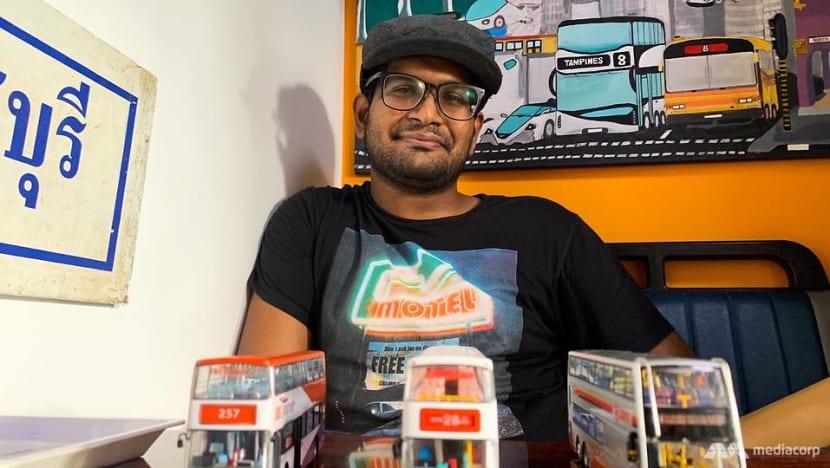
“As a kid I always wanted to have a bus, but I know it's really impossible in this country. Then when I was 16 years old … I decided to email a bus company and say: ‘Would you sell one?’” he recalled.
“They didn't know (I was 16) and then they managed to quote me a price which was kind of reasonable for an adult ... I didn't even know where to get the money from. I remember I was thinking: ‘Hey let's do a fundraiser, every bus enthusiast can chip in 100 dollars and you can own a part of the bus,’” he said.
The purchase eventually fell through as buses are required by law to be scrapped after their years on the road.
Said Mr Santhosh: “You only live once, no harm trying, even if you're going to get rejected, you’re still at the same place you were before.”
A ‘SANCTUARY’ FROM THE WORLD
For Mr Ahamed, public buses would be a sanctuary after the death of his father.
“When I was very young, my obsession kept changing, initially it was traffic lights, then road sweepers … Then it shifted to trains, because my mom kept showing me Thomas The Tank Engine - back then it was the greatest show ever,” he told CNA.
“And because my dad was a big petrol head ... then it moved to cars for a bit."
His passion was then diverted to buses. "In those days in primary school, because my dad passed away after that, the bus was my sanctuary. Nobody was with me, I could take my mind off (things), and then I would be alone. A safe space.”
After school, the youngster would hop on buses, which would take him all over the island.
“When I got old enough to take the bus myself, I started deviating and going off to all sorts of places around Singapore, to the point I think once I came home at nine o'clock, and my mom got fuming mad because she said: ‘What kind of remedial class ends at 9pm?’” he recalled.

When it comes to buses, what is of particular interest to Mr Syabiel are the sounds that their engines make.
“The buses back then were really loud and noisy, the noise would surround me and I would be in peace,” he explained. “I wanted to listen to different sounds, because I was able to take this certain model, I wanted to know how each model sounded like.”
While taking buses, Mr Ahamed would make it a point to record these engine noises with his phone’s recorder.
“Back then because the fleet was very diverse, they all had different sounds,” he said. “The gearbox has a whine. The way the engine rumbles, when it clatters, especially when it clatters, it is very nice.”
‘IT REALLY TAKES YOU TO PLACES’
While both Mr Santhosh and Mr Syabiel are not as active in the bus enthusiast community as they were in the past, they remain passionate.
Mr Santhosh for one, has taken to photography and videography, which has opened doors for him to work with bus companies to take pictures of their fleets.
“A lot of people think this hobby is really weird, really crazy, but to me, I see it differently. I think it's really amazing for people to be passionate about something. And if you're passionate about something, it really takes you to places that you would never have thought,” he explained.
“That's the most important thing I realized through this hobby. I started out liking buses, evolved into photography, videography, next thing I know I’m working with the bus companies doing photography and videography for them. And that led me to media, and advertising.”
Mr Syabiel continues to upload the sounds of bus engines on his Youtube channel. Currently, he has over one thousand subscribers. It is like ASMR (autonomous sensory meridian response) but for "bus people", he explained.
He now also drives part-time for a private bus company - fulfilling what was a childhood dream.
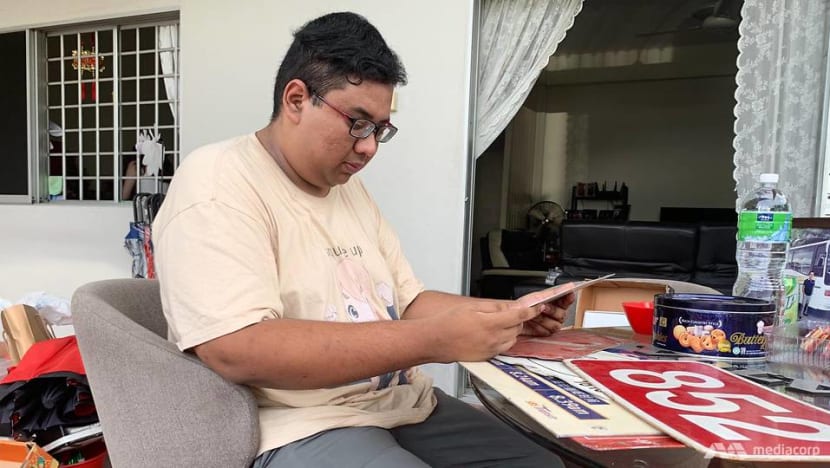
After getting his military driving license during National Service, he went on to obtain his vocational license, and currently juggles between his studies and driving.
“It was super unreal,” said the 25-year-old. “I actually was at home where I had a set-up where I (could practice drive). So, basically, I used a simulator to train myself. So, over the years, I kept training, training, training.”
Mr Syabiel is currently taking up an automotive engineering course at ITE in order to beef up his technical knowledge, with his plan down the road to work as a technical adviser for one of the major bus manufacturers.
His eventual goal? To move to New Zealand, where buses can be kept as private vehicles.
Seeing the buses from his childhood being scrapped is also a reminder of how quickly things have changed, added Mr Syabiel.
“It's very sad for me because it's like watching my whole world start crumbling because all the vehicles that were a sanctuary to me have all gone,” he explained. “There was a certain model retiring, a double decker bus … it was introduced in 2003, to me it was the newest thing because back then I was 8.
“But now watching it age and watching it die, it is a sign that I have grown, that I am old. I went to the scrapyard to see the bus die, I sat in the seat for the last time … I just sat there and it brought me back many years to when the bus was still new.”
In a room in his family’s Bukit Panjang flat, Mr Kumar has painstakingly restored and repurposed a number of items from old buses, giving them a new lease of life.
There is the iconic ticket machine, which he has converted into watch cabinet, a ‘Frankenstein’ seat with parts from different Trans-Island buses turned into a desk chair and a bus fare box which he hopes to turn into a piggy bank in the future.
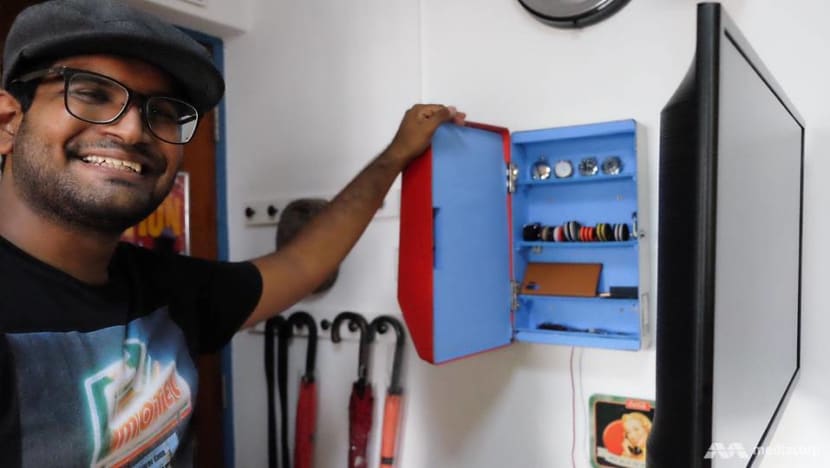
The vivacious 21-year-old also continues to jump on bus rides during his leisure time.
“As much as I have I've explored Singapore a lot and gone around to places where some people may not even have been, I can safely say that I’ve only been to 40 per cent of the country because there's still a lot of hidden nooks and crannies that you don’t really see,” he said.
“Sometimes I will take a bus route that I always take and then I’ll notice something different.”
One particular bus route continues to hold memories and meaning for him - bus service 925.
“That is the same route that I used to (take to) go to the scrapyards. There’s a section of the route where it passes by Kranji Dam, Kranji Reservoir … The bus will do a three point turn and come back and you get to see Malaysia for a moment of time,” he explained.
“As a kid, that was like a moment where I could de-stress. You just look at another country ... to me it was like maybe on the other side, there’s somebody also de-stressing, looking over to Singapore.”
Even now, Mr Kumar finds himself returning to that spot.
“To me, (it is about) the memories of taking the bus after the scrapyard. I’d got my goodies, and I was looking at the view … So many things have changed, but I’m still the same person - intrigued by this stuff.”












